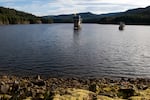
FILE: Bull Run Watershed in 2019. Portland relies on the watershed for drinking water. The city recently began building a filtration system to remove animal scat and contaminants from wildfires.
Kaylee Domzalski / OPB
Portland has begun constructing a $2.1 billion water filtration system that will remove contaminants derived from animal fecal matter and wildfires.
The city is building the filtration plant on a 94-acre property in east Multnomah County, northeast of Boring, where residents can expect to see more traffic as workers install fencing, dig pipeline trenches and pour concrete.
Portland needs to complete the system by September 2027 to comply with federal limits on cryptosporidium, a fecal contaminant that officials have tied to wildlife in the heavily forested Bull Run Watershed.
But the biggest concern for Portland water officials is not cryptosporidium.
“While it’s the driver [of the facility], it isn’t our biggest risk to the health of our customers,” David Peters, the supervising engineer heading the filtration project, said. “It’s the risk of having to shut down our drinking water system and not being able to provide water during a wildfire.”
When a wildfire hits the watershed, as one did last year, it adds sediment like ash and leaves to the reservoirs. That earthy debris — known in the water treatment world as turbidity — reacts with chlorine during the treatment process, resulting in a poisonous chemical byproduct.
When turbidity levels are high enough, Portland has to switch to groundwater wells, which have half the capacity of the Bull Run Watershed. That’s not nearly enough to satiate Portland’s water needs during peak summer months.
Portland is funding the project through low-interest loans from the Environmental Protection Agency and several rate increases. Its price tag has ballooned since city officials approved it in 2017, which the bureau ties to increasing construction and materials costs.
Once the system is completed, Portland will no longer be among five major cities that don’t filter drinking water. The others are Seattle, New York, San Francisco and Boston.
Portland won’t filter for ‘forever chemicals’
While the new system will help with federal rules on cryptosporidium, it won’t address new rules for cancer-causing “forever chemicals” called PFAS (per- and polyfluoroalkyl substances).
This spring, the EPA announced regulations requiring all water utilities regularly test for six types of PFAS. If utilities exceed newly adopted limits, then they have five years to install pricey filtration systems to remove the toxic chemicals.
The Portland Water Bureau says the city’s drinking water is at low risk for PFAS. The bureau is pulling samples from the watershed every quarter through 2025, and so far, none have come up positive. A bureau spokesperson said groundwater wells will be tested for PFAS next time they’re activated this summer.
PFAS are called forever chemicals because they don’t break down. They’re found in water, air, wildlife and soil around the world, and nearly all people in the U.S. have PFAS in their blood. These man-made chemicals are resistant to oil, heat, stains and water, so manufacturers use them in a host of consumer products, including outdoor clothing, waterproof makeup and food packaging.
The Portland Water Bureau says there are no known PFAS sources near the Bull Run Watershed. When PFAS contaminate public drinking water, the source can typically be tied to firefighting facilities, industrial sites, landfills or wastewater treatment plants. PFAS can also enter drinking water through the air and rain.
Three sites use PFAS-containing firefighting foam near the city’s backup groundwater wells: the Portland International Airport, Portland Air National Guard Base and a Portland Fire and Rescue training facility. Water samples from two wells near those sites tested negative for 12 types of PFAS in 2018 and 2023.
Correction: An earlier version of this story had an incorrect figure for the number of PFAS the Environmental Protection Agency plans to require water utilities to test for. EPA regulations will require utilities to test for six types of PFAS.
